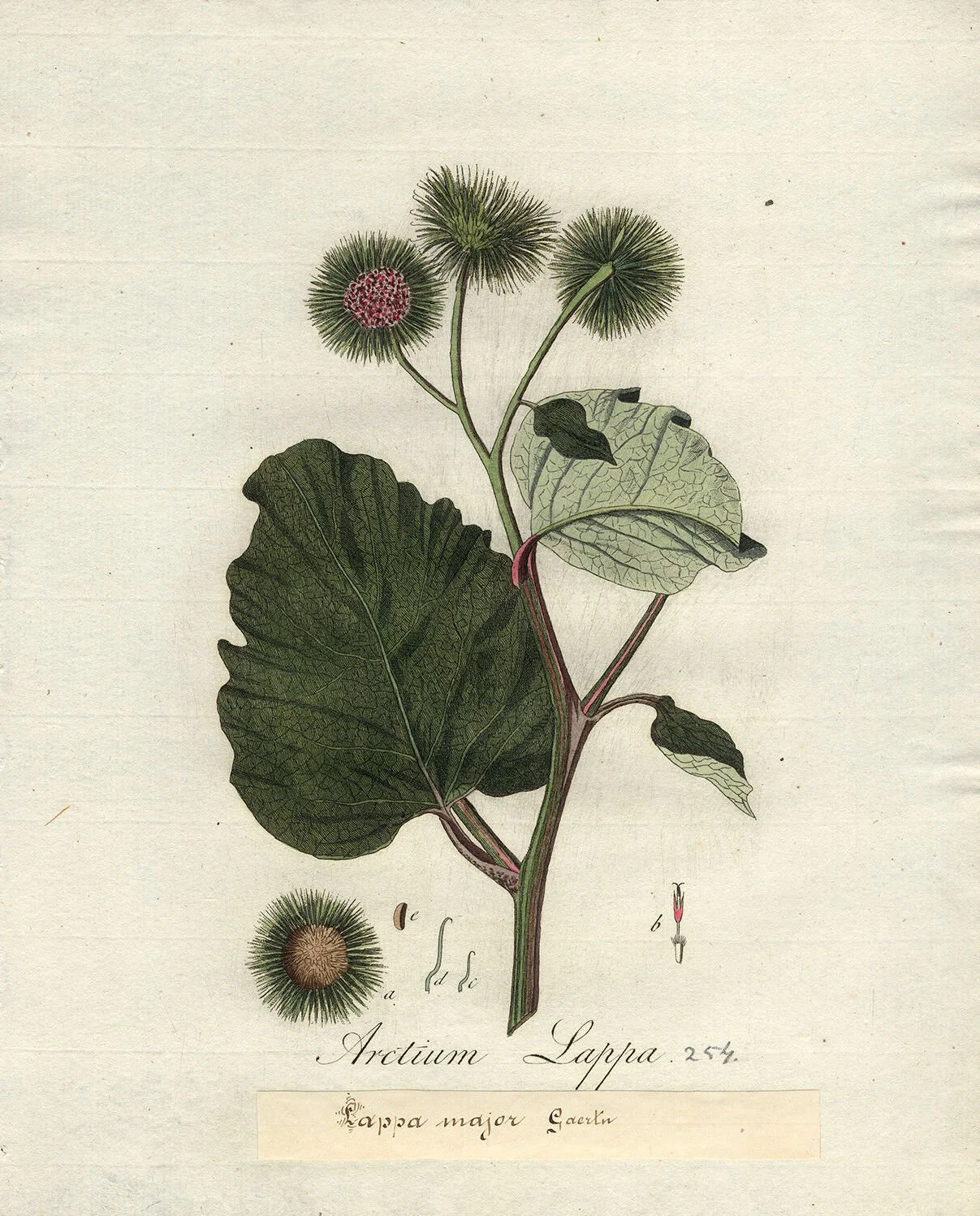Jupiter's Stabilizing, Nourishing, & Grounding Burdock
The old Hippocratic adage of, “let food by thy medicine, and medicine be thy food,” truly applies to burdock. This wild plant, used for food and medicine, is native to Asia, North Africa, and Europe and can often be found in depleted soil, roadsides, random fields, and other places throughout the world. It flowers from July through August, making lovely pinkish/purple thistle-like blooms, but it’s the roots and seeds that we’re after for medicinal use!
Burdock is a plant with an incredibly expansive presence – it has huge green leaves sort of like elephant ears – thick sturdy stems with a taste reminiscent of artichokes when cooked – and tall flowering stalks in its second year of growth. It is also a plant that rarely grows in isolation. Burdock does a great job at spreading itself out, growing a nourishing plant community that not only acts as food and medicine for humans and non-human kinfolk, but also deeply restores the health of the soil all around them, healing the Earth as well.
The genus for Burdock is Arctium, deriving from the Ancient Greek word for a bear, arktos (αρκτος). Its species name, lappa, derives from the Latin word lappare meaning "to seize", in reference to the burs. Maud Grieve writes in A Modern Herbal (1971) that the word lappa may derive from the "Celtic llap, a hand," but it would be more correct to specifically delineate which Goidelic or Brythonic language she is referencing, as 'Celtic' is a group name rather than a specific language. I think she's referring to Gaeilge, but there are many different words for hand – I was able to find that lapa means the paw of an animal, and I could surely see burdock being referred to as "bear paw" plant, but this is my own conjecture, not a historically rooted reference.
“A Burdock—clawed my Gown—
Not Burdock’s—blame—
But mine—
Who went too near
The Burdock’s Den—”
According to John Cameron's text, The Gaelic Names of Plants (1883), burdock is known by many names/phrases in Scottish & Irish: suirichean suirich, meaning "the foolish wooer"; or siercean suirich "affectionate wooer"; mac-an-dogha "the mischievous plant"; meacan-tobhach-dubh "the black or large plant that seizes"; leadan liosda "stiff head of hair"; copag tuaithil "the ungainly docken"; or ceosan "the bur or fruit".
Grieve also writes that the old English name for Burdock was herrif, arieve, or airup from the Anglo-Saxon hoeg, a hedge, and reafe, a robber – or from the Anglo-Saxon verb reafian, to seize (Grieve, 1971). I really can't find other etymology resources that corroborate this. That said, the word dock was the name for various tall, coarse weeds or herbs, being docce in Old English, from dokkon in Proto-Germanic. Bur, c. 1300, referred to the prickly seed vessel of some plants. The name burdock seems to have shown up by the 16th century (Etymology Online, 2021).
“Max cheosan air sgiathan fhirein.
Like bur clinging to the eagle’s wing.”
Folklore, Myth, & Legend
The folklore surrounding burdock is seemingly sparse. I'm surprised that I wasn't able to find much about this plant's associations throughout Asia, save a reference on Central Asian folkloric textile motifs.
My friend Sharon Arnold clued me in to a connection between burdock and Central Asian textile arts (thank you Sharon!) Burdock, pıtrak in Turkish, shows up in woven textiles called kilim, flat-woven, pileless rugs. Different motifs for burdock adorn these textiles, with the belief that the visual talisman will ward off the evil eye. Burdock is also a symbol of abundance and this motif also shows up on flour bags (Kilim Studio, n.d.). Here are some examples of burdock motifs that show up throughout the region:




I was thrilled to find out after writing this that the rug that always lived in my family's foyer has burdock designs on it. This is one of the only heirlooms we have since it was one of the few things my mom was able to take with her when emigrated. I'm pretty sure it was made in my grandfather's textile factory, but I'm not sure. All I really know is that it hung on the wall of my grandparent's home back in the USSR, was later given to my mother, and will someday be part of my home. Many thanks to the burdock offering us protection for all of these years.
In Europe – where so much folklore was documented, preserved, and is still in circulation today – burdock was mostly considered a potherb and vegetable. Some of the only European related folklore I could find comes from Richard Folkard's Plant Lore, Legends, and Lyrics (1884) where he writes:
“It was under the great leaf of a Burdock that the original Hop-o’-my-Thumb, of nursery-rhyme celebrity, sought refuge from a storm, and was, unfortunately, swallowed, enclosed in the leaf, by a passing hungry cow. InAlbania, there is a superstitious belief that, if a man has been influenced by the demons of the forest, the evil spirit must be exorcised by the priest; a portion of the ceremony consisting of the steeping of bread in wine, and spreading it on the broad leaves of a Burdock.”
Similar to the Central Asian use as a protective charm against the evil eye, burdock was also hung above stable doors in Germany and Lithuania to protect cattle from curses (Teirlinck, 1926).
Burdock is one of the most widely used plants in traditional medicinal systems throughout the world. The roots are most commonly used, due to their powerful and yet gentle alterative action that helps to cleanse the blood, relieve liver stagnation, and alleviate skin issues. It has also been historically used for blood disorders, skin concerns, irritation of the urinary tract, rheumatism, and gout. The leaves and fruits are also used, but often to a lesser extent.
When it comes to astroherbalism, burdock is a classic example of a Jupiter-ruled herb. Burdock root physically and energetically grounds our sense of being, helping us to root ourselves in both the world around us and our own bodies. Through its relationship with Jupiter, Burdock ultimately provides the stability of generous nourishment, helping to restore the body, promoting health and vitality, and giving us the faith and trust to move forward on our paths with vigor and momentum.
There is so much to say about burdock’s myriad of applications, folklore, and spiritual connections. If you’re curious about learning more about how to engage with this plant safely through both food and herbal preparations, I invite you to check out the latest monograph in Herbaria!
Herbaria is our online, accessible community herbalism program that helps you connect with herbs with the support of community connection. Here's a preview of what you'll find there:
Extensive monographs on plants including their myth, magic, medicine, & cultural associations
Simple & nourishing recipes to support you through the seasons
Resources on wildcrafting, magical herbalism, and other supportive guides
Live monthly workshops with guest teachers (including past replays!)
Support on your plant path from an expansive group of wise witches & plant folk
and so much more!
To join Herbaria and get access to the full-length Burdock monograph, visit the link below:
Join Herbaria
…and gain access to the Burdock monograph + recipes, resource guides, and other materials to support you in this season.
I hope this plant profile in Herbaria inspires you to invite the stabilizing grounding nature of burdock into your garden, herbal practice, and life.
Warmly,
Sarah
Disclosure: This information has not been evaluated by the Food and Drug Administration and is not intended to diagnose, treat, cure, or prevent any disease. Consult with a qualified healthcare practitioner before using herbal products, particularly if you are pregnant, nursing, or on any medications.




